Unlike most marine fish, herring rely on specific benthic (seabed) habitat to reproduce. They typically spawn in environments with elevated oxygen levels, which lowers egg mortality [1, 2]. This may be areas with strong currents, over coarse substrate (e.g., gravel, small rocks, shingle, coarse sand, broken mollusc shells) and on photosynthesising marine plants [3, 4].
In Scottish waters, herring reproduce in autumn or spring. Autumn-spawning herring spawn primarily near offshore banks in the North Sea and to the west of the Hebrides. Spring-spawning herring spawn in shallower nearshore environments along the west coast, typically in March (see video) [5]. When referring to spawning locations, a “spawning bed” is a discrete patch of seabed where herring eggs are deposited, and a “spawning ground” is a larger geographic area encompassing one or more spawning beds and all the adjoining potential spawning habitat [6].

Along the west coast of Scotland, spring-spawning herring frequently spawn over beds of coralline red algae, called maerl, a Priority Marine Feature in Scottish seas. Seabed geomorphology and salinity are also important habitat cues for the selection of spawning beds by herring schools [7]. Availability and conservation of essential spawning habitat is key for this benthic spawner, yet knowledge of location and status of spawning beds is scarce in some areas, especially the west coast of Scotland [1]. The ‘West of Scotland Herring Hunt’ project is identifying and producing evidence for the conservation, and potentially restoration, of herring spawning habitat on the Scottish west coast.
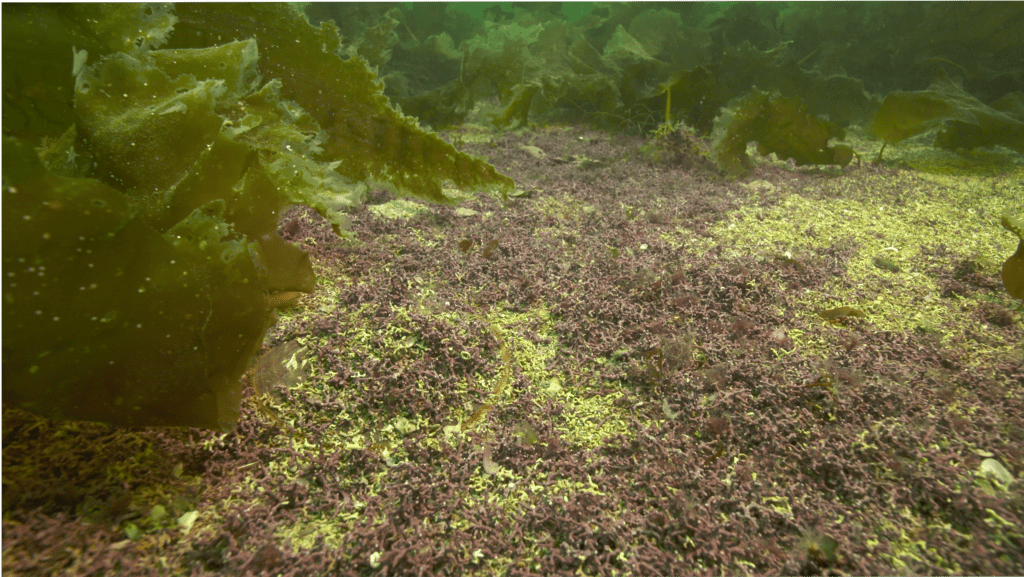
Prior to spawning, herring populations gather close to spawning grounds in areas with similar environmental conditions. Adult herring usually return to the spawning grounds where they hatched. Females then deposit their eggs onto the seabed. The eggs stick onto the substrate, forming dense layers. The total number of eggs laid per female varies from 21,000 to 47,000 [8]. Males follow closely and release ribbons of milt which sink and fertilise the eggs. Herring spawn in multiple waves with repeat spawners spawning first, followed by first-time (recruit) spawners [9]. This results in a build-up of egg masses consisting of different development stages. Hatching of the larvae occurs between 7 days to 3 weeks after spawning, depending on temperature. Cold water slows the development of embryos [10]. Light to moderate winds and wave action induce larval hatching due to increased aeration of the spawn [11].
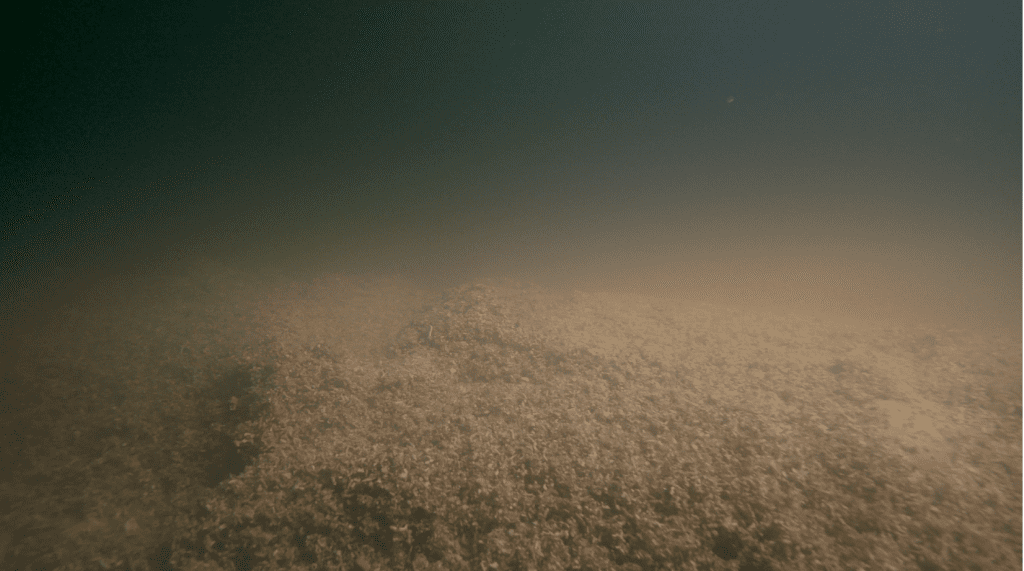
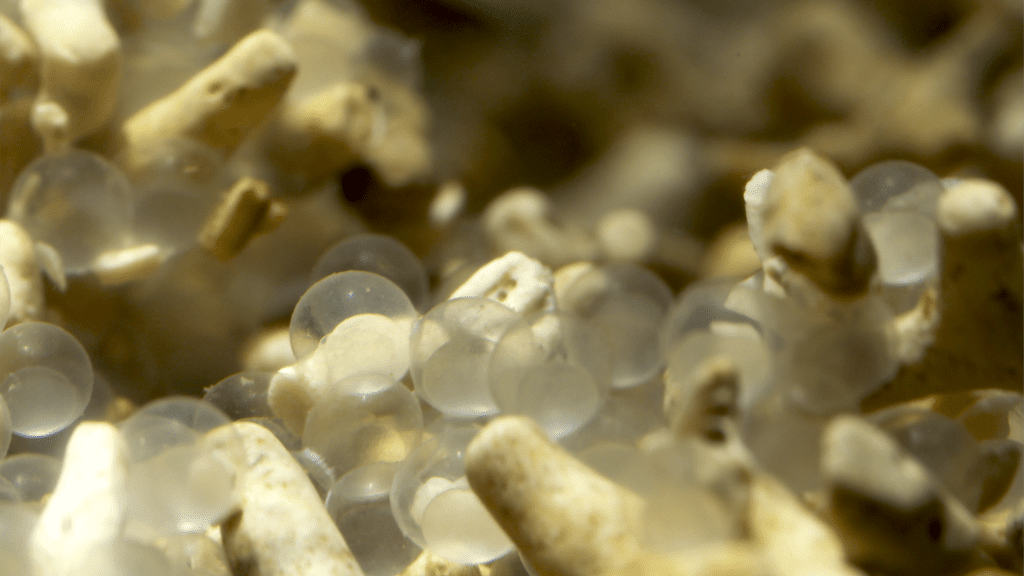
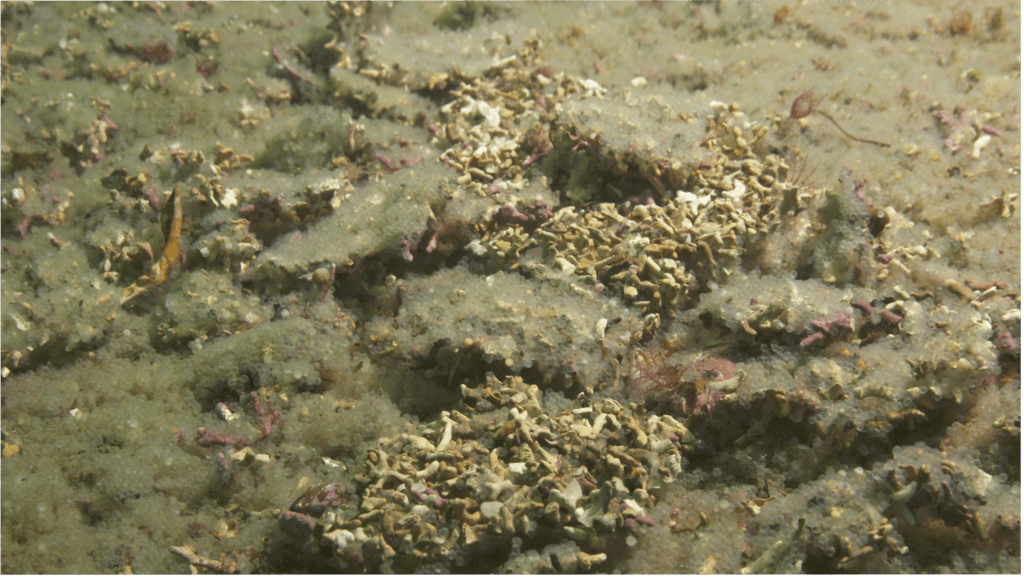
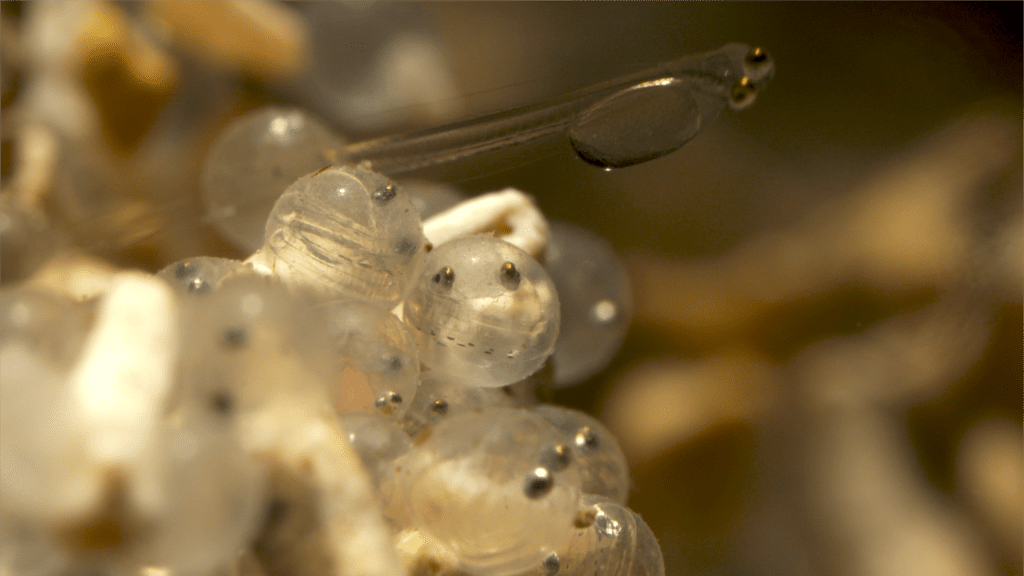
Larvae of spring-spawning herring hatch with large yolk-sac reserves. This allows them to grow until summer, when plankton is abundant, and they metamorphose into juveniles. Autumn-spawning larvae hatch after the productive summer feeding season. They are capable of surviving, without much growth, over extended periods in cooler, less productive waters until metamorphosing in spring [10]. Larvae are planktonic (floating in the water) and remain near spawning grounds [12] or passively drift to nursery areas in the north and east of Scotland on the prevailing currents [13]. Once mature, individuals will form large shoals that migrate between feeding grounds, spawning grounds and overwintering areas [14].

Banner image: Herring eggs on maerl. © Andy Jackson, SubSeaTV; reproduced with permission.
[1] Aneer G (1989) Herring (Clupea harengus L.) spawning and spawning ground characteristics in the Baltic Sea. Fish Res 8:169–195. https://doi.org/10.1016/0165-7836(89)90030-1
[2] von Nordheim L, Kotterba P, Moll D, Polte P (2018) Impact of Spawning Substrate Complexity on Egg Survival of Atlantic Herring (Clupea harengus, L.) in the Baltic Sea. Estuaries and Coasts 41:549–559. https://doi.org/10.1007/s12237-017-0283-5
[3] Woods HA, Podolsky RD (2007) Photosynthesis drives oxygen levels in macrophyte-associated gastropod egg masses. Biol Bull 213:88–94. https://doi.org/10.2307/25066621
[4] Phillips NE, Moran AL (2015) Oxygen production from macrophytes decreases development time in benthic egg masses of a marine gastropod. Hydrobiologia 757:251–259. https://doi.org/10.1007/s10750-015-2256-7
[5] Frost M, Diele K (2022) Essential spawning grounds of Scottish herring: current knowledge and future challenges. Rev Fish Biol Fish 32:721-744. https://doi.org/10.1007/s11160-022-09703-0
[6] O’Sullivan, D., O’Keefe, E., Berry, A., Tully, O., and Clarke, M. (2013). An Inventory of Irish Herring Spawning Grounds. Irish Fisheries Bulletin No. 42: Marine Institute
[7] Moll D, Kotterba P, von Nordheim L, Polte P (2018) Storm-Induced Atlantic Herring (Clupea harengus) Egg Mortality in Baltic Sea Inshore Spawning Areas. Estuaries and Coasts 41:1–12. https://doi.org/10.1007/s12237-017-0259-5
[8] Cunningham JT (1896) The Natural History of the Marketable Marine Fishes of the British Islands. The MacMillan Co. New York.
[9] Skaret G, Slotte A (2017) Herring submesoscale dynamics through a major spawning wave: Duration, abundance fluctuation, distribution, and schooling. ICES J Mar Sci 74:717–727. https://doi.org/10.1093/icesjms/fsw180
[10] Geffen AJ (2009) Advances in herring biology: from simple to complex, coping with plasticity and adaptability. ICES J Mar Sci 66:1688–1695
[11] von Dorrien C, Hammer C, Zimmermann C, et al (2013) A review on herring, clupea harengus (Actinopterygii: Clupeiformes: Clupeidae) recruitment and early life stage ecology in the western baltic sea. Acta Ichthyol Piscat 43:169–182. https://doi.org/10.3750/AIP2013.43.3.01
[12] Bartsch J, Brander K, Heath M, et al (1989) Modelling the advection of herring larvae in the North Sea. Nature 340:632–636. https://doi.org/10.1038/340632a0
[13] Dragesund O, Hamre J, Ulltang Ø (1980) Biology and population dynamics of the Norwegian spring-spawning herring. Kapp. P.-v. Riun. Cons. int. Explor. Mer 177:43-71.
[14] Barreto E, Bailey N, (2015) Fish and Shellfish Stocks. Marine Scotland Science.
Email: [email protected]